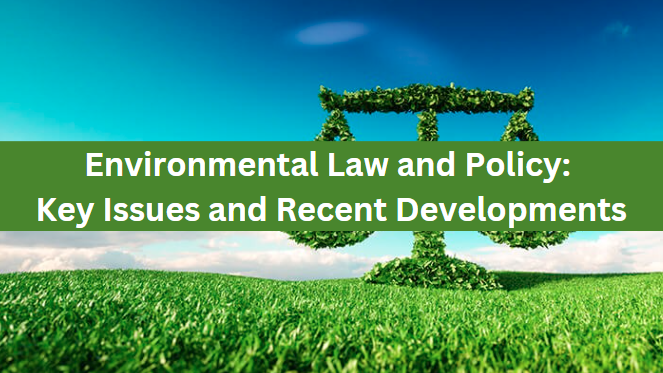Environmental law and policy play a critical role in addressing the challenges of climate change, pollution, and conservation of natural resources. As global environmental concerns continue to grow, legal frameworks and policies are evolving to meet these challenges. This article explores the key issues in environmental law and policy and highlights recent developments shaping the future of environmental protection.
Contents
1. Climate Change Legislation
International Agreements
- Paris Agreement: A landmark international accord adopted in 2015, aiming to limit global warming to well below 2 degrees Celsius above pre-industrial levels. Countries commit to reducing greenhouse gas emissions through nationally determined contributions (NDCs).
- COP26 Outcomes: The 2021 United Nations Climate Change Conference (COP26) resulted in commitments to phase out coal, reduce methane emissions, and provide financial support to developing nations for climate adaptation and mitigation.
National Policies
- United States: The Biden administration has rejoined the Paris Agreement and introduced the American Jobs Plan, which includes significant investments in clean energy, electric vehicles, and infrastructure resilience.
- European Union: The European Green Deal aims to make the EU climate-neutral by 2050. Key components include the European Climate Law, which legally binds member states to reduce emissions, and the Fit for 55 package, targeting a 55% reduction in emissions by 2030.
2. Pollution Control
Air Quality Regulations
- Clean Air Act: In the United States, the Clean Air Act regulates air emissions from stationary and mobile sources. The Environmental Protection Agency (EPA) sets National Ambient Air Quality Standards (NAAQS) to protect public health and the environment.
- European Emission Standards: The EU sets stringent emission standards for vehicles and industrial sources to reduce air pollution and protect air quality.
Water Pollution Laws
- Clean Water Act: This U.S. federal law regulates discharges of pollutants into the waters of the United States and quality standards for surface waters. It aims to restore and maintain the chemical, physical, and biological integrity of the nation’s waters.
- EU Water Framework Directive: Establishes a framework for protecting and improving water quality across the EU, setting environmental objectives for surface waters, groundwater, and coastal waters.
Waste Management and Plastic Pollution
- Extended Producer Responsibility (EPR): Policies that hold producers accountable for the entire lifecycle of their products, including end-of-life disposal. EPR aims to reduce waste and promote recycling.
- Single-Use Plastics Directive: The EU has introduced measures to ban certain single-use plastic products, reduce plastic waste, and promote sustainable alternatives.
3. Conservation and Biodiversity
Wildlife Protection
- Endangered Species Act (ESA): A key U.S. law aimed at protecting critically imperiled species from extinction. The ESA provides for the conservation of ecosystems upon which threatened and endangered species depend.
- Convention on Biological Diversity (CBD): An international treaty aimed at conserving biological diversity, promoting sustainable use of its components, and ensuring fair and equitable sharing of benefits arising from genetic resources.
Protected Areas and National Parks
- Global Protected Areas: Initiatives like the Global Biodiversity Framework aim to protect at least 30% of the world’s land and ocean areas by 2030 to conserve ecosystems and prevent biodiversity loss.
- National Park Legislation: Countries around the world have established national parks and protected areas to preserve natural landscapes, ecosystems, and wildlife habitats.
4. Renewable Energy and Sustainable Development
Renewable Energy Policies
- Incentives and Subsidies: Governments offer financial incentives, tax credits, and subsidies to promote the development and adoption of renewable energy sources like solar, wind, and geothermal.
- Net Metering: Policies that allow homeowners and businesses to sell excess renewable energy back to the grid, encouraging the installation of renewable energy systems.
Sustainable Development Goals (SDGs)
- United Nations SDGs: The 17 SDGs provide a global blueprint for achieving sustainable development by 2030. Key goals related to environmental protection include Clean Water and Sanitation (Goal 6), Affordable and Clean Energy (Goal 7), and Climate Action (Goal 13).
5. Environmental Justice
Addressing Disparities
- Environmental Justice Movement: Advocates for the fair treatment and meaningful involvement of all people, regardless of race, color, national origin, or income, in the development, implementation, and enforcement of environmental laws, regulations, and policies.
- Biden Administration Initiatives: The administration has launched initiatives like the Justice40 Initiative, which aims to deliver 40% of the overall benefits of federal investments in climate and clean energy to disadvantaged communities.
Legal and Policy Frameworks
- Civil Rights and Environmental Law: Legal frameworks that address the intersection of civil rights and environmental protection, ensuring that vulnerable communities are not disproportionately affected by environmental hazards.
6. Recent Developments and Future Trends
Technological Innovations
- Green Technologies: Advances in green technologies, such as carbon capture and storage (CCS), electric vehicles (EVs), and renewable energy storage solutions, are transforming the environmental landscape.
- Digital Tools: The use of digital tools like satellite monitoring, big data analytics, and blockchain for environmental tracking and enforcement is increasing.
Corporate Responsibility and ESG
- Environmental, Social, and Governance (ESG) Criteria: Investors and stakeholders are increasingly considering ESG criteria in their decision-making processes, pushing corporations to adopt sustainable practices and reduce their environmental footprint.
- Corporate Sustainability Reporting: Regulations requiring companies to disclose their environmental impact and sustainability efforts are becoming more common, promoting transparency and accountability.
International Cooperation
- Global Environmental Agreements: Continued international cooperation and agreements are essential for addressing transboundary environmental issues and achieving global sustainability goals.
- Climate Finance: Mobilizing financial resources to support climate mitigation and adaptation efforts in developing countries remains a critical focus for the international community.
Conclusion
Environmental law and policy are at the forefront of efforts to combat climate change, protect natural resources, and ensure sustainable development. By understanding key issues and staying informed about recent developments, individuals, businesses, and governments can contribute to a more sustainable and equitable future. As environmental challenges continue to evolve, so too must our legal and policy frameworks, embracing innovation and collaboration to address the pressing environmental issues of our time.




